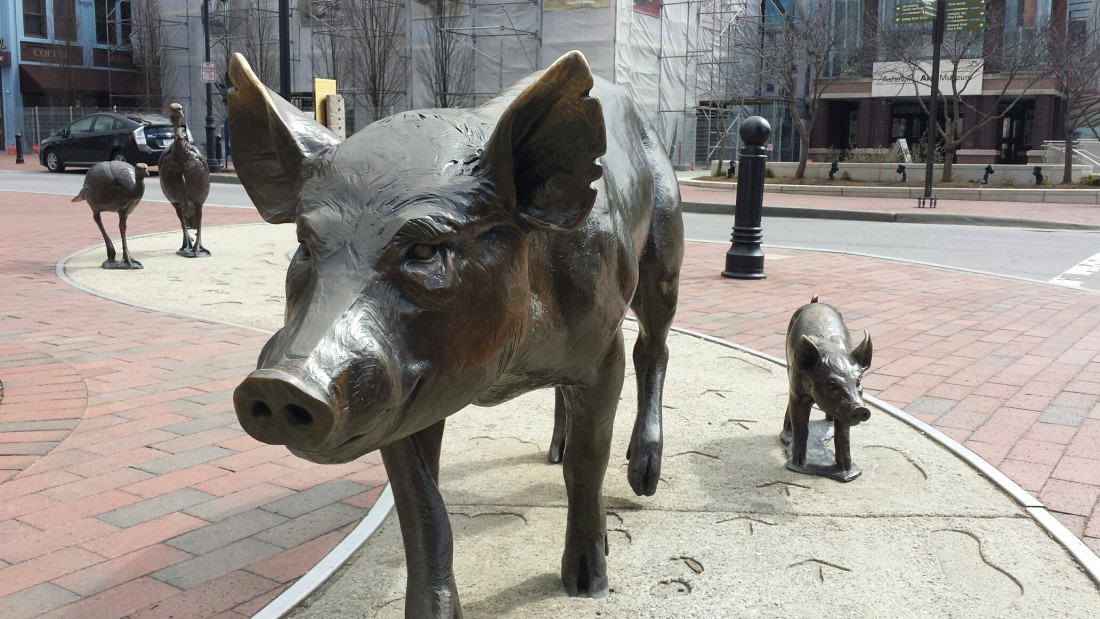Downtown Asheville contains, within its handful of blocks, an astonishing number of public artworks. But while the Pack Square pig is fun to ride, and the giant flat iron sculpture at the entrance to Wall Street has served as the backdrop to countless vacation photos, those who are visiting Asheville or new to the city might not realize that the collection of outdoor, interactive art has a purpose beyond amusement. Thirty sculptures, plaques, installations and bronze replicas tell the story of Asheville in a linked and walkable self-guided tour known as the Urban Trail.
“I had no idea any of those sculptures were part of any kind of trail until the city hired me,” says filmmaker Erin Derham. “Now I’m on board to make it as visible as possible.” Among other films, Derham is known for Buskin’ Blues, a glimpse into Asheville’s street performers. Her local, woman-owned production company was selected to make a 14-minute documentary funded by the city of Asheville’s Public Art Program. A press release describes the film as a “short oral history [that] preserves the project’s origins and early years through conversations with the pioneers who were there.”
On Tuesday, March 8, the film will screen on the City Channel at 4:44 p.m. in advance of the City Council meeting.
Derham’s documentary, filmed over the course of three days, includes group and individual interviews with the likes of local historian Mitzi Tessier; Grace Pless, a member of the Urban Trail’s board of directors; and Leslie Anderson, who spearheaded downtown revitalization efforts beginning in the 1980s. Local musician Ben Lovett created the score. “The artists who were chosen always have a story, whatever the statue represents has a story, and the donor — why the donor gave money for the station — has a story,” Derham says. “It’s 30 times three. It’s really interesting.”
The 1.7-mile path was launched in 1991 by a group of volunteers. The various stations were designed mainly by local artists, including Vadim Bora, who created “Cat Walk” (Station No. 9); Kenn Kotara, who fashioned “On the Move” (Station No. 21); and James Barnhill, who sculpted “Childhood” (Station No. 26).
In an ashevilleguidebook.com story from the time of the trail’s opening, Mickie Booth writes, “Tourists, city workers, children, retirees and residents of the city and surrounding counties have expressed their interest. … Some have generously funded the markers, plaques and large works of art, which are the heart of the trail. Others, city and office worker, gardener, student, homemaker and historian, give to the trail the valuable gifts of time and talents.”
According to Brenda Mills, manager of the city’s Public Art Program, interest in the trail hasn’t waned. Referrals from the Convention and Visitors Bureau, the Thomas Wolfe House, the Asheville Art Museum and local bed-and-breakfasts send a steady stream of visitors to those 30 stations. “It seems to be something people want to know more about,” says Mills.
While the trail — which is owned and maintained by the city of Asheville — is complete, there’s a possibility of creating similar public art projects in other areas of Asheville, such as the South Slope. “I’ve gotten at least three or four requests from other cities that want to do the same thing, and they just want to know what we did,” says Mills.
But the main objective with the documentary was to conserve the stories of those who conceived the Urban Trail. “This trail is over 27 years old, so there are people who are older,” says Mills. “We didn’t want to lose those voices.” She applauds Derham’s ability to cull hours of footage into 14 minutes that encapsulate the project.
“In the film, you’ll see every piece of the Urban Trail,” says Mills. Five or six stations are featured in detail. With this spotlight on the unique piece of local history and culture, Mills says the next steps include building new partnerships and creating school curricula around the trail, and training tour guides. “We want to have something sustainable throughout the years,” she says. “It’s less about making money than highlighting a wonderful downtown that has evolved.
The film can be viewed on Charter Cable Channel 193, AT&T U-Verse Channel 99 and can be streamed online at ashevillenc.gov/livestream.aspx. Additional events around the Urban Trail and the documentary will be announced later this year.
Find the self-guided walking tour here.




Before you comment
The comments section is here to provide a platform for civil dialogue on the issues we face together as a local community. Xpress is committed to offering this platform for all voices, but when the tone of the discussion gets nasty or strays off topic, we believe many people choose not to participate. Xpress editors are determined to moderate comments to ensure a constructive interchange is maintained. All comments judged not to be in keeping with the spirit of civil discourse will be removed and repeat violators will be banned. See here for our terms of service. Thank you for being part of this effort to promote respectful discussion.